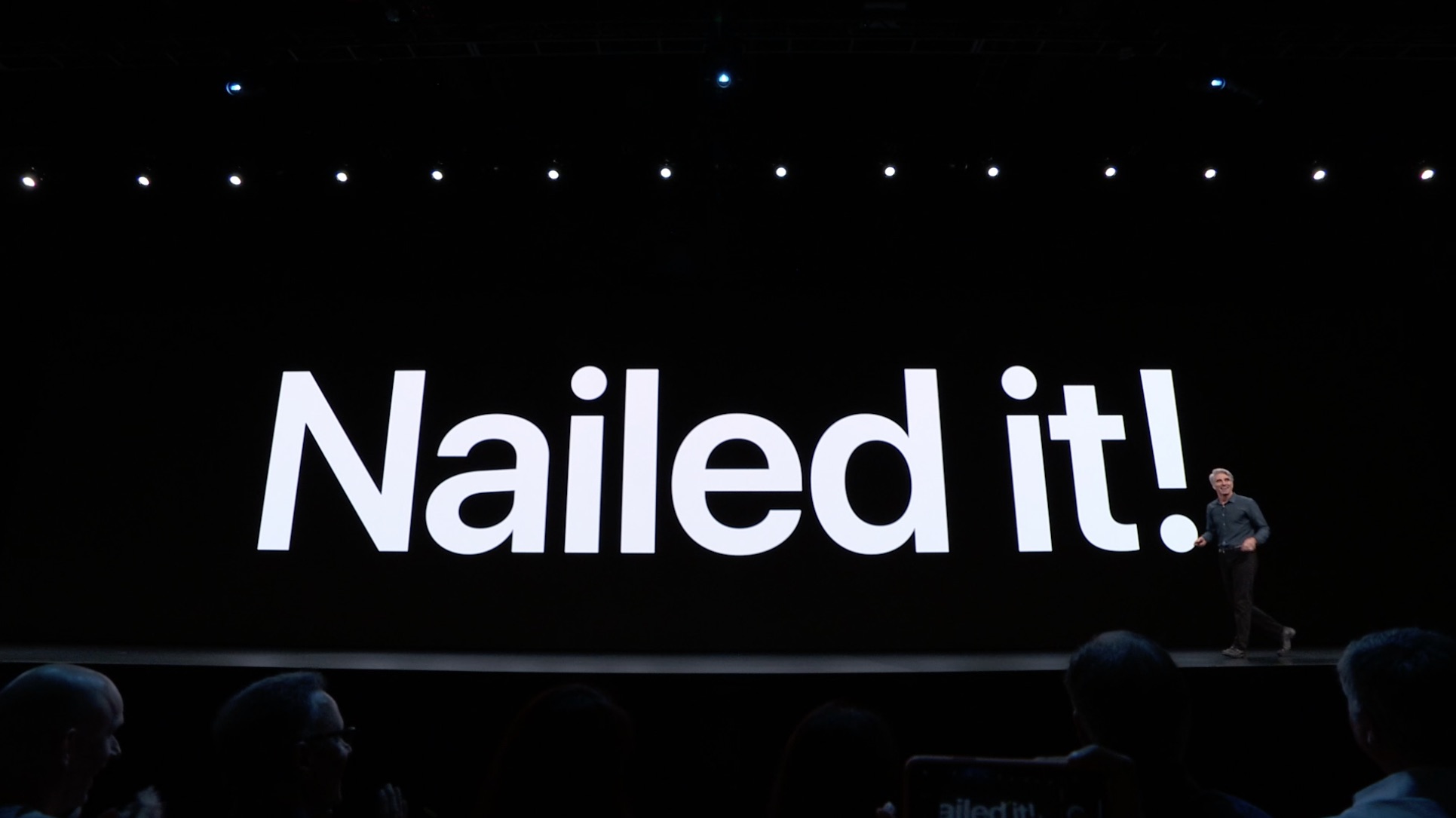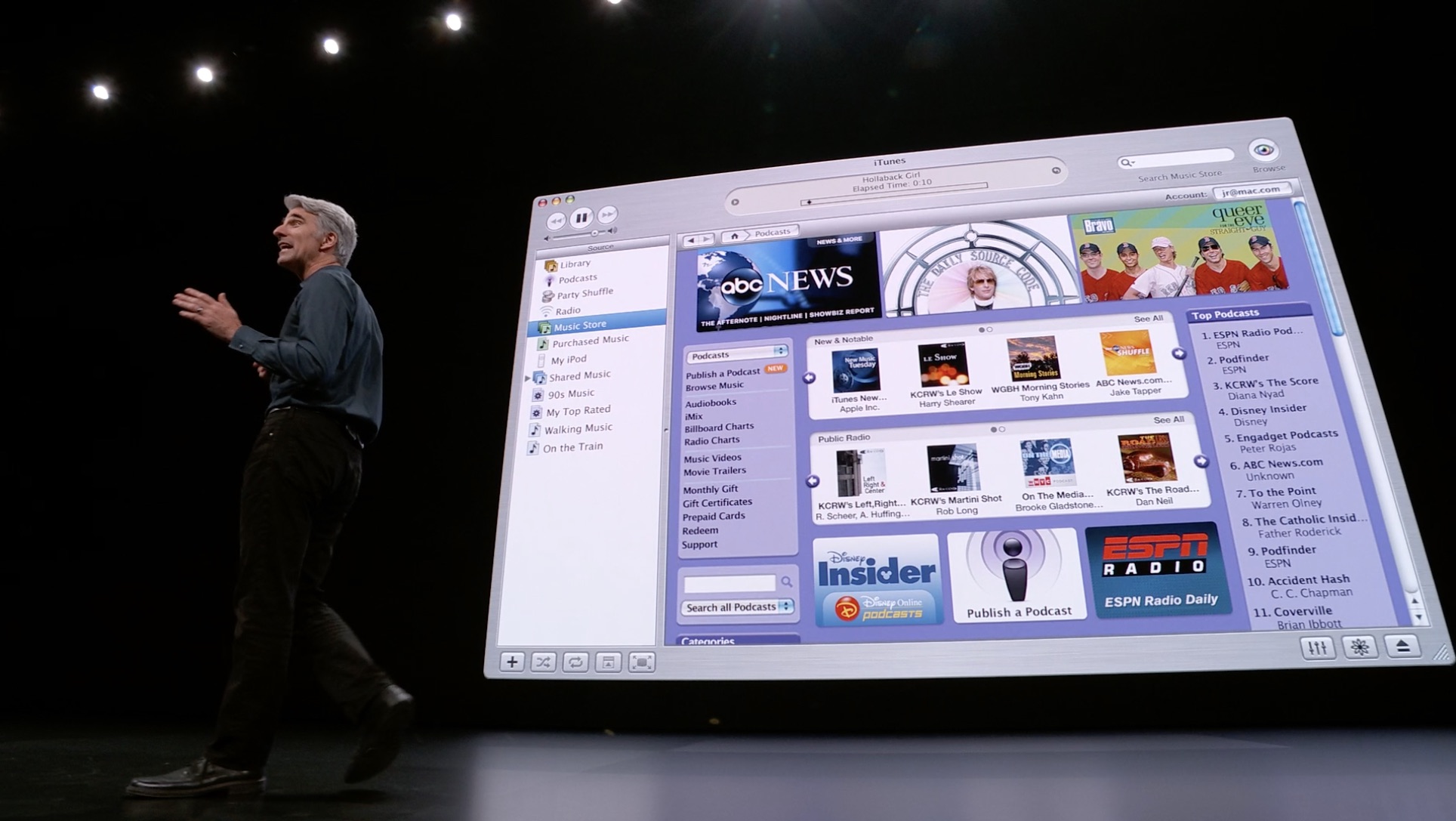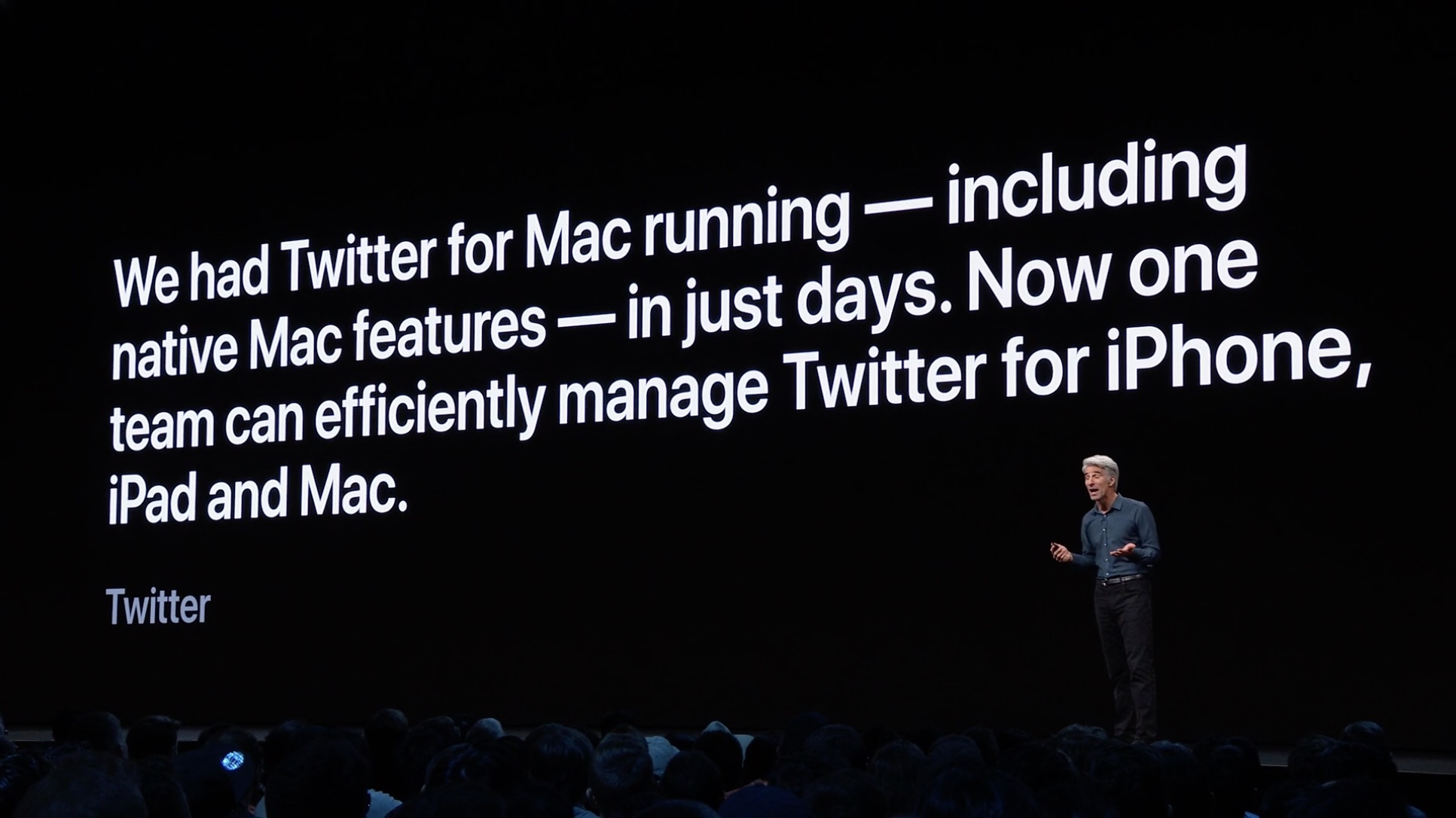
Apple just finished the annual keynote event at its Worldwide Developers Conference (WWDC), the two hours each year when Apple tells us the most about what’s coming up on the platforms that power iPhones, iPads, Macs, Apple Watches, and Apple TVs. (Its hardware announcements get sprinkled across several dedicated events throughout the year; today is always the big day for software.) And this was a big day — so big, in fact, that it ballooned out almost 20 minutes past its usual timeslot.
There weren’t any game-changing announcements specifically targeted at news publishers the way there have been in some years past. (Most notably, announcements around in-app subscriptions, the old Newsstand, and the various iterations of Apple News.) But there was still a lot of interest for those of us in the content-production business. Here’s my news-focused rundown of the highlights; check out your favorite neighborhood liveblog for more.
R.I.P. iTunes, hello Apple Podcasts. It was a product built for an earlier era, one where getting access to new content was complicated and built around actual physical distribution, if you can believe it.
At the time, it was revolutionary — combining lots of different kinds of content and information into one easy-to-access hub. That final step of delivery, which had been a real hassle before? This took care of it for you.
It could gather pieces of professional content from out in the world and compress them down into a portable device; walking around with one of those made you seem au courant. There were ways to get those pieces of content before, of course, but putting them into this single bundle enabled an entirely new business that threw off a lot of revenue for a long time. In a diffuse market, this was the sort of thing it took a strong company known for its centralized command-and-control to wrangle together.
But over time, it became a little too bloated — and a lot too clunky. Trying to be everything to everybody wasn’t a sustainable strategy; the company just kept stuffing in more and more features until it became heavy, slow, and at times borderline unusable.
A new generation of products came along, born of ubiquitous wireless data instead of physical distribution. The new guys usually tackled only one of the many problems the bloated old mess had evolved to deal with. In the end, it was the marketplace that determined its future more than the company that made it — to survive and compete, it had to be broken into pieces.
But enough about newspapers!

Okay, it’s an imperfect metaphor, but both iTunes and newspapers made perfect sense in their original contexts, and neither has been able to fully adapt to the more agile group of mammals scurrying around the App Store. Bundles gotta bundle. (Apple’s Craig Federighi said at one point that “customers love iTunes,” earning repressed guffaws from the audience before he made it clear he was in on the joke.)
The divvying-up of iTunes’ jobs happened some years ago in iOS, but now it’s coming to Macs. One app is being split into three: Apple Music, Apple TV, and of most interest to publishers, Apple Podcasts, which will bring “a dedicated podcast-listening experience to the Mac.”
I don’t think that a native podcasts app on the Mac will do much to move the needle of listening; the rise of smartphones has meant that laptop time is now more focused on work than it used to be, and I don’t see much reason most podcast listening would move to the desk.
That said…there’s a reason that many people tie the podcast boom of recent years to Apple deciding to include a separate Podcasts app on in iOS 8 in 2014. Every Mac user upgrading to macOS Catalina will now have a Podcasts app icon right there in the Dock. That’s exposure that’s hard to get, even if the Mac userbase is a small fraction of the iPhone’s. And on a more practical level, a Mac app might remove a step when someone hears about an interesting show on desktop but doesn’t want to jump to the iPhone to subscribe.
The biggest news for podcasts — which was presented as part of the new Mac app but which I have to imagine will also be available on mobile — is full-text podcast search. Apple will now use machine learning (of course) to index the spoken content of all the podcasts in its database and make it searchable. Overhear someone talking about a podcast episode about Welcome Back, Kotter lunchbox? This search should mean you can type in those words and get directed to the Mystery Show episode you’re looking for.
I don’t know how useful this will be as a discovery tool — I don’t know how many overheard Mystery Show conversations are someone’s entry point into podcasts — but if done right, it could be amazing as a reporting and research tool. Imagine being able to search for a person’s name and find every podcast episode she’s ever been a guest on or even mentioned on. We’ll see what search is like in practice, but it could be like Google Search for one of the most opaque forms of popular media.
Developers, developers, developers. This is a developers’ conference, after all, so while there’s always a lot of interest for end consumers, the audience in the room wants tools to make their coding easier and their apps more powerful.
Perhaps the biggest developer news for publishers was Project Catalyst, which appears to be the rebranding of what has been previously known as Marzipan — a toolkit that makes it easy to convert iPad apps into Mac apps. (Apple announced Marzipan this time last year; the easy conversion of iPad apps comes this fall, and the expectation is that iPhone-to-Mac conversions will arrive a year after that.) Marzipan has been controversial among Mac devotées who, not without reason, worry about junky iPad interfaces polluting their pristine aluminum slabs. But it’s the future, man, get with it.
In terms of the size of their userbases, the Mac is a fraction of the iPad, and the iPad is a fraction of the iPhone. But if it really is a relatively easy lift, why wouldn’t publishers like The New York Times, The Washington Post, The Guardian, or the Financial Times invest in a quick port to Mac? News consumption levels on digital platforms line up well with the periods of time that information workers are sitting at their desks; if you can earn a place in someone’s Dock — and thus send native-app push notifications, not just their janky web equivalent — it seems like a worthwhile investment for the big players.
(In what can only be projected as a hit on journalistic productivity, Twitter announced during the keynote that Project Catalyst would enable them to have a native Mac desktop app once again, since it can now share a codebase with its iOS apps. Yay?)

The most impassioned reaction from developers, though, might have come near the end when Apple unveiled SwiftUI, a new framework that promises to remove a lot of the grunt work in coding user interfaces for apps. Lots and lots of oohs and aahs, which suggests your coder friends will find a lot to like.
There was also the obligatory demo of new AR stuff, and it deadened the room like every obligatory demo of new AR stuff before it. Augmented reality is still a ways away from prime time.
Lucky iOS 13. The big pitch behind the new version of iOS is “we figured out how to use the color black,” so maybe it’s not shocking that there wasn’t a ton I saw in the unveiling of the new operating system for publishers to get hyped up about. Apps will now be 50 percent smaller when downloaded, with updates 60 percent smaller, and launch speeds will be up to twice as fast, which is all to the good.
One interesting thing, announced during the iOS segment but not limited to it, is a new “Sign in with Apple” feature that will be competitive with all the “Sign in with Facebook” and “Sign in with Google” buttons you see on every new web app you come across. It’ll offer a new way to let users speed up the account-creation-and-log-in step that’s the bane of bounce rates everywhere. It’ll work in both apps and on the web (unclear whether that’s Safari-only or not). I know from past conversations that, despite the increased ease of use, publishers aren’t eager to hand over their login process to Facebook or Google, which are happy to use all that tasty user data for their own advertising purposes. The fact that Apple isn’t trying to monetize that data and has taken a stronger stance on privacy might make it appealing to some publishers.
For AirPods users (they keep making more of them), Apple announced an “Announce Messages” feature that will let Siri read incoming messages when you have your AirPods on without any user action. No phone buzz, no tapping a notification — the message comes in and you just hear it in your ear jewelry.
While that sounds like it has enormous potential to be annoying — having every text I get read to me while I’m trying to listen to a podcast sounds hellish — Apple did say that the ability to do this will be available to “any third-party messaging app using SiriKit.” I’d imagine Apple would go strict constructionist on what qualifies as a “messaging app,” but I do wonder if an enterprising news developer could make it read the most important/urgent/interesting news alerts accordingly.
Finally — critically for accessibility purposes but potentially quite useful for all writers — both iOS devices and Macs will now have much more thorough integration of voice control, letting people navigate through a huge share of their computing tasks with only their voice. The demo was pretty amazing, but it also might be useful for writers who like to dictate their pieces.
The birth of iPadOS. This isn’t going to impact how people read the news much — but it will make life a lot better for journalists who have to write or edit text (and, god forbid, HTML) on an iPad. What had been iOS — covering both phones and tablets — has now been split into iOS (for phones) and iPadOS (for iPads, duh), representing the fact that iPads are now often used more like keyboard-optional laptops than giant smartphones. (It’s unclear to me the degree to which “iPadOS” announces a truly distinct operating system — one that could be updated at a pace distinct from iPhones’, for instance — or just a new label that acknowledges the diverging use cases.)
iPadOS brings a host of nice touches that are boring on regular ol’ computers but feel like a bright sunny morning on a tablet: widgets on your homescreen, easier multitasking and app switching in Slide Over, multiple windows open per app, more mature file system access (folder sharing! thumb drives!), and what Apple is calling “desktop-class web browsing” in Safari, which I confess confuses my little responsive mind a bit. But maybe most dramatic for us word types is improved cursor moving, easier text selection, and a simpler, three-finger-gesture-driven interface for cut, copy, paste, and undo. I’ll be air-typing Command-Z, X, C, and V long after the rest of my neurons have gone limp, so if we finally have a reasonable path to the Holy Quaternity of text editing, I will be thrilled.
One other iPad update of interest: You will now be able to use an iPad as both an external screen for your Mac (expanding the desktop of your MacBook) and as a wireless drawing tablet of the sort Wacom is famous for. Both could be useful for journalists.
A more independent watchOS. The software that runs Apple Watch started out as a sidecar to the iPhone; the watch itself didn’t have the computing power to do much more than take and show data from the supercomputer in your pocket. To install an Apple Watch app, you had to install a corollary iPhone app first. Even publishers that were all in at the watch’s launch got frustrated by the clunkiness of the whole arrangement, in some cases killing off their apps altogether.
That’s changed in stepwise fashion as each new Apple Watch has been more powerful than the last. But there were still a few governors left in place, and the new version of watchOS clears many of them away. You can now have a watch app that isn’t attached to a phone app. That’s possible because the Apple Watch will have its own native App Store, accessible on your wrist.
Watch apps from news organizations have thus far been little more than notification butlers, and I suspect that’s not about to change. But I do think the ability to build strictly for the watch might encourage some startup to build a next-generation notifications experience designed solely for that little screen. (I sometimes wonder what the team behind the old Breaking News app would come up with if they were still consumer-focused and hadn’t pivoted to enterprise.)
The other major change for publishers is that iOS’ streaming audio APIs will now be available on Apple Watch. That opens up a new world of possibilities for radio stations, podcasters, and other sorts of audio streamers. If you wanted to have a decent third-party audio app on the watch before, you had to rely on hacks, slow file transfers from the phone, and wifi, not cellular. That’ll now change. (Though the biggest beneficiaries will obviously be music apps like Spotify — assuming Apple gives their competitor access, of course.)
Finally, the new watchOS will include Activity Trends to monitor your health over time, showing online reporters just how motionless they stay at their desk typing and that the standing desk isn’t really making a difference if we’re all being honest.
A new Mac for your high-end wishlist. Apple unveiled a new (and loooooong-awaited; its trashcan-manqué predecessor came out in 2013) $5,999 Mac Pro, which looks like an absolute cheese-grating monster. In a demo of audio editing in Logic Pro, Apple said it can handle 1,000 different audio tracks and 1,000 different software instruments at the same time. There are not, to my knowledge, many news organizations that need to edit 1,000 audio tracks at the same time (or show 100 million pixels in video editing session), but I can already picture folks in publishers’ video shops drafting boss memos detailing why, exactly, they absolutely need one of these things under their desks yesterday. (Same thing for photo editors with Apple’s new $4,999 Pro Display XDR, which features 120 million pixels, a 1,000,000:1 contrast ratio, and other very large numbers I’m not in a real position to evaluate.)
A (mis)step toward gender equity. For many years, Apple events were — just like most news industry events — sausage fests. Dude after dude after dude after dude after Eddy Cue. Amazingly, it wasn’t until 2015 — 38 years into Apple’s existence! — that even the first female Apple executive presented on stage at a keynote. (Before then, a grand total of three women had ever spoken on Apple’s stage: two app developers and the model Christy Turlington.)
Apple’s gotten substantially better at this in the past few years, and I was excited to start writing this section midway through the event when I noticed that the male/female count of presenters was even at four of each. Sure, the four men were each higher-level execs than the four women, and Apple’s leadership still has the gender dynamics of a cigar bar — but stage equity is still something, right?
But then a bunch of men came on stage and, unless I miscounted, the final tally was 10 men versus 6 women. Not quite a manel, but still in the same area code. Maybe next year.